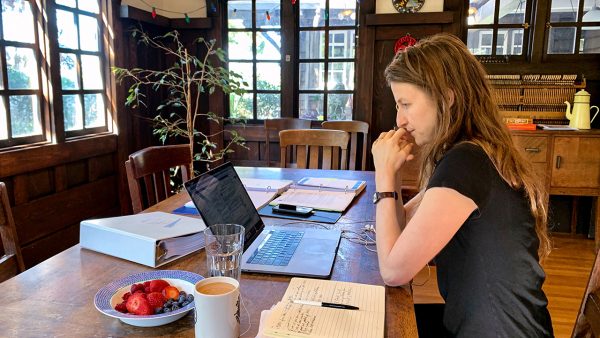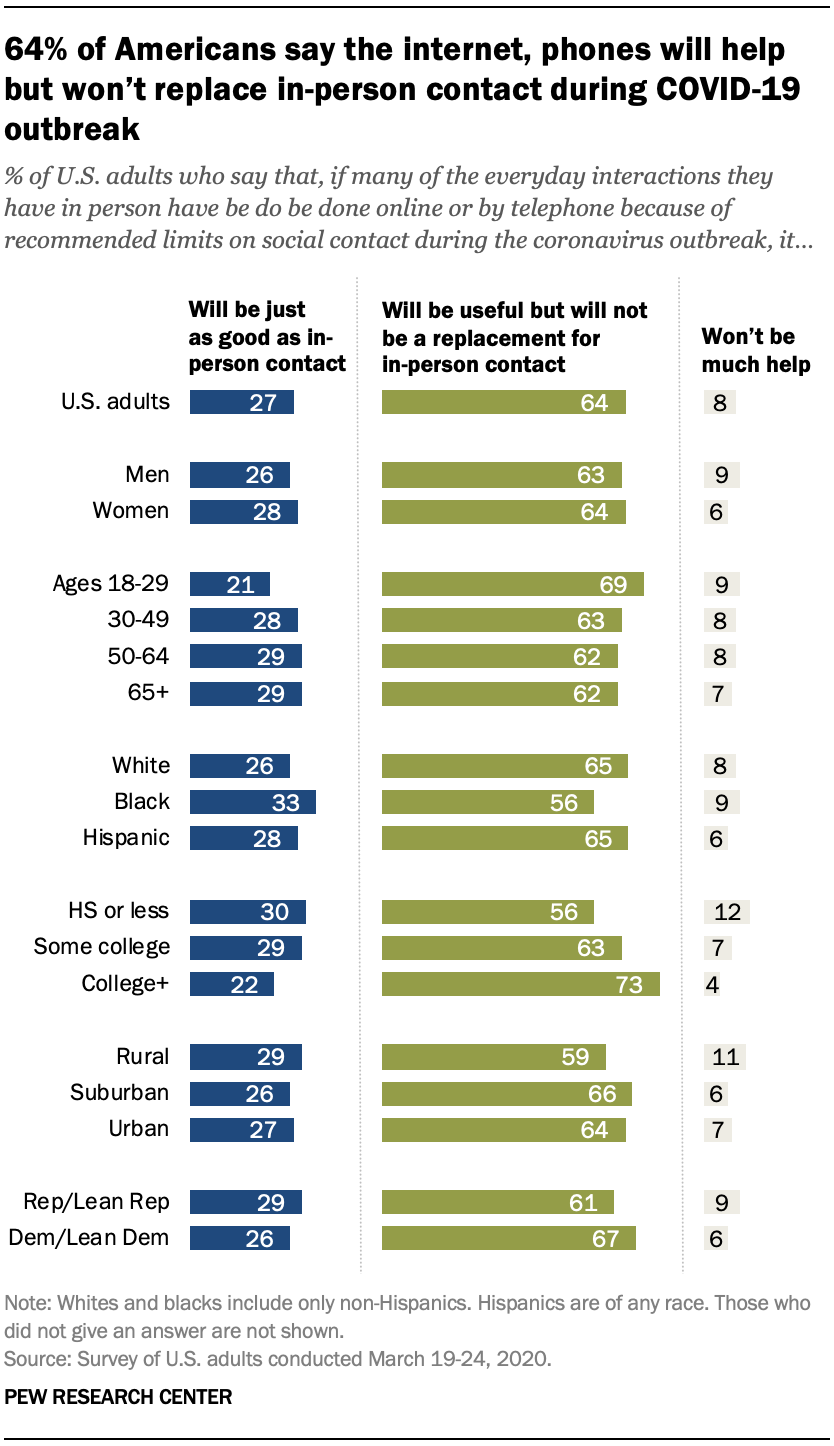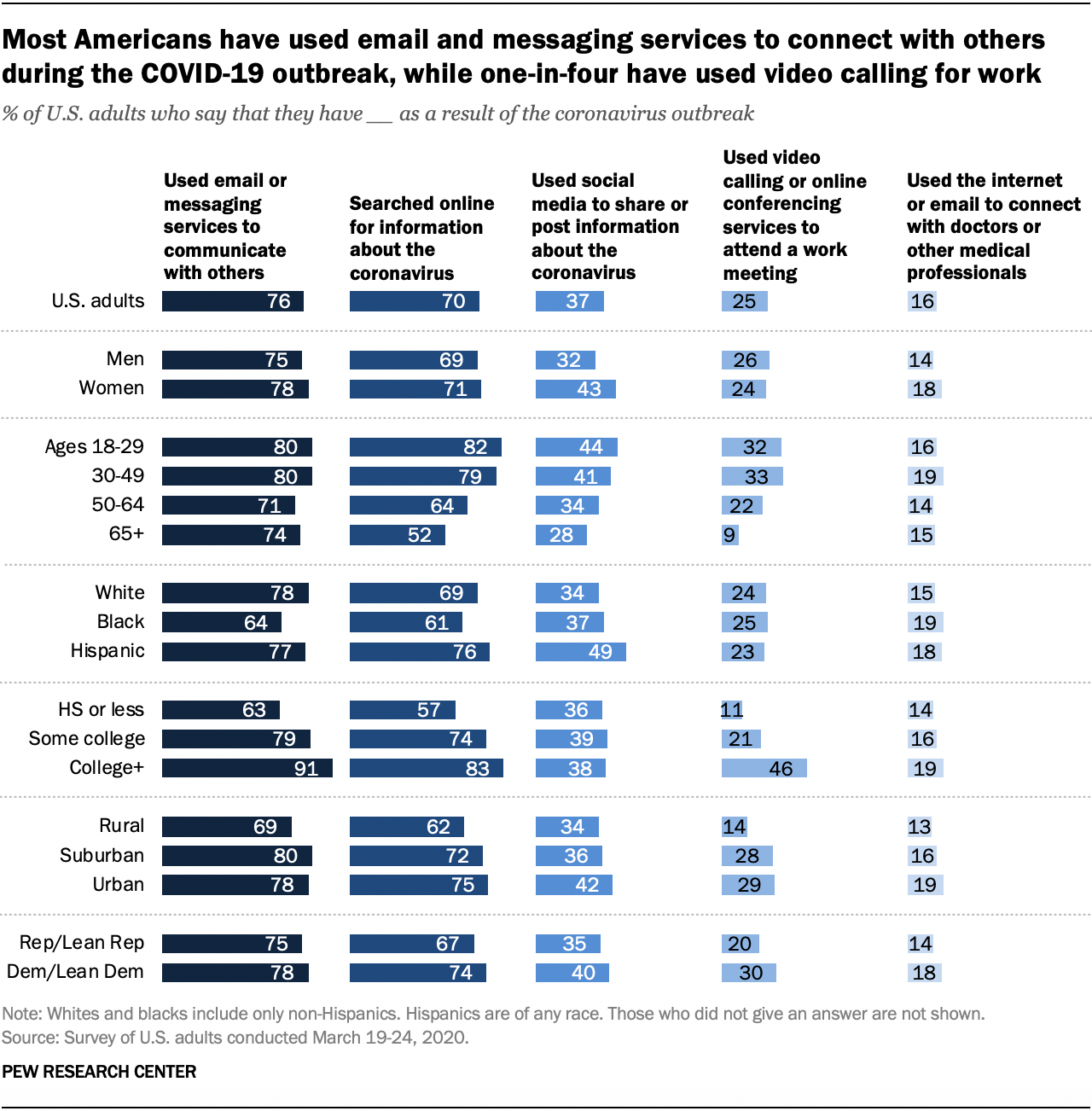Amid COVID-19, tech or internet outage seen as a very big problem by 49% in US – Pew Research Center

As the spread of COVID-19 upends work, classes and even doctor appointments across the country, a majority of Americans are turning to digital means to stay connected and track information about the outbreak.
Amid this increased reliance, about nine-in-ten U.S. adults (93%) say that a major interruption to their internet or cellphone service during the outbreak would be a problem in their daily life, including 49% who foresee an outage being a very big problem for them and 28% who believe it would be a moderately big problem.
But while digital connections may provide an alternative during a time of social distancing, only a minority (27%) thinks interacting via these technologies will be as effective as in-person contact. Some 64% of Americans think the internet and phones will help but are not a replacement for face-to-face encounters.
These are key findings from a Pew Research Center survey of U.S. adults conducted online between March 19-24 on the Center’s American Trends Panel.
How we did this
Pew Research Center conducted this study to understand how Americans in different parts of the country are responding to the new coronavirus outbreak. This analysis focuses in particular on the role digital technology plays in people’s day-to-day lives during the outbreak. For this analysis, we surveyed 11,537 U.S. adults from March 19 to 24, 2020. Everyone who took part is a member of Pew Research Center’s American Trends Panel (ATP), an online survey panel that is recruited through national, random sampling of residential addresses (see our Methods 101 explainer on random sampling). This way nearly all U.S. adults have a chance of selection. The survey is weighted to be representative of the U.S. adult population by gender, race, ethnicity, partisan affiliation, education and other categories. Read more about the ATP’s methodology.
Here are the questions used for this report, along with responses, and its methodology.
Large shares of Americans are using digital technology to keep in contact with others, search for outbreak-related information
Asked about a range of activities they have performed in response to the coronavirus outbreak, roughly three-quarters (76%) of Americans say they have used email or messaging services to communicate with others, while 70% report that they have searched online for information about the coronavirus. By comparison, fewer Americans – though still about four-in-ten – say they have shared or posted information about the outbreak on social media.
As more companies move to encouraging – or requiring – telework, one-quarter of those surveyed say they have used video calling or an online conferencing service, like Zoom or WebEx, to attend a work-related meeting due to the coronavirus outbreak. Smaller shares of Americans (16%) report using the internet or email to connect with doctors or other medical professionals as a result of the outbreak.
There are some differences by education level, age, and race and ethnicity when it comes to how these digital activities are used as the country copes with the virus.
For example, it is far more common for college graduates to hold virtual meetings than those with less formal education. Nearly half of college graduates (46%) say they have participated in a work meeting by using video calling or online conferencing, compared with 21% of those with some college experience and 11% who have a high school education or less. College graduates are also more likely than those who have some college experience or a high school education or less to say they have used email or messaging services to communicate with others or look up information online related to the outbreak.
There are also age differences across most of these experiences. The largest gap is evident when it comes to seeking outbreak-related information online. Some 52% of adults ages 65 and older say they have used the internet to search for information about the coronavirus, but that share rises to 64% among those ages 50 to 64 and 80% among adults under the age of 50.
Across each measure, rural Americans are less likely than those living in urban areas to report using these digital tools. And Hispanic adults (49%) are more likely than black (37%) or white adults (34%) to report using social media to share or post coronavirus-related content.
Americans are worried about a potential interruption in digital services
 Previous Center surveys have found that Americans widely view a high-speed internet connection as essential or important. Mobile technology is also playing a large role in how people go online – particularly for Americans who rely on their smartphone to do everything from getting news or searching for health information to looking for a job.
Previous Center surveys have found that Americans widely view a high-speed internet connection as essential or important. Mobile technology is also playing a large role in how people go online – particularly for Americans who rely on their smartphone to do everything from getting news or searching for health information to looking for a job.
The new survey shows that majorities across demographic groups believe that losing internet or mobile connectivity during the outbreak would be disruptive to their daily lives, but how big of problem they foresee this causing varies substantially across demographic groups.
Roughly nine-in-ten Americans (93%) say that a major interruption in their internet or cellphone service during the coronavirus outbreak would be a problem for daily life in their household. This includes 49% who foresee this being a very big problem for them and 28% who believe this would be a moderately big problem. A smaller share says this would be a small problem (16%), and just 6% say it would not be a problem at all for daily life.
Roughly six-in-ten Americans who have a bachelor’s or advanced degree (59%) say a major interruption in their internet or cellphone service during the outbreak would be a very big problem in their daily lives, compared with 50% of those who have some college experience and 40% of those who have a high school diploma or less.
Adults under the age of 65 (53%) are far more likely than those 65 and older (38%) to see this kind of disruption as a very big problem for their daily life. On the other hand, those living in rural areas (39%) are far less likely to believe a major interruption to their internet or cellphone service would a very big problem for them than those living in urban (57%) or suburban (50%) areas.
There are also differences by race and ethnicity, as well as by gender. Black and Hispanic adults are more likely than white adults to view an interruption to their internet or cellphone service as a very big problem. And women are more likely than men to believe this would cause a significant issue in their daily life.
It is important to note that previous Center studies have shown that Americans’ digital connectedness and reliance on technology varies across demographic groups. For example, younger adults as well as those living in cities or suburbs use the internet more frequently. They are more likely to own a smartphone and to use that technology to perform digital tasks.
Will the internet and phones be an adequate substitute for in-person interactions?
 Even as the public describes a major interruption to their internet or phone service as disruptive, only a minority thinks interacting via these technologies would be just as good as face-to-face contact with others.
Even as the public describes a major interruption to their internet or phone service as disruptive, only a minority thinks interacting via these technologies would be just as good as face-to-face contact with others.
Asked what will happen if many of the everyday interactions they have in person have to be done online or by phone because of the coronavirus outbreak, 27% say these technologies will be just as good as in-person contact. By comparison, the largest share (64%) says these tools will be useful, but will not be a replacement for face-to-face communications, and just 8% say the internet or phones won’t help much at all during this time. This pattern holds true across each major demographic group.
Still, there are some notable differences by educational attainment. Roughly three-quarters of college graduates (73%) say that if their everyday in-person interactions have to be done online or by phone, it will help but not be a replacement for in-person contact. That share falls to 63% among those who have some college experience and 56% among Americans with a high school education or less.
By contrast, there are more modest differences by age or race and ethnicity. White or Hispanic adults (65% each) are more likely than black adults (56%) to say interacting online or through a phone will be useful but won’t be a full substitute for face-to-face communication. And adults under the age of 30 are somewhat more likely to express this view than those ages 30 and older (69% vs. 63%).
Note: Here are the questions used for this report, along with responses, and its methodology.







